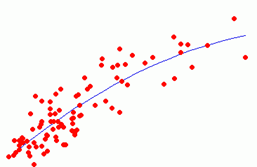Ceres Solver: 高效的非線性優化庫(一)
Ceres Solver: 高效的非線性優化庫(一)
注:本文基於Ceres官方文件,大部分由英文翻譯而來。可作為非官方參考文件。
簡介
Ceres,原意是穀神星,是發現不久的一顆軌道在木星和火星之間“矮行星”(冥王星降級之後,同為矮行星)。Google開源了Ceres Solver庫,是一個解很多非線性最優化問題的高效、方便的工具。
- 官方網站:http://ceres-solver.org/
- 原始碼地址:https://github.com/ceres-solver/ceres-solver
- 主要特性:速度快、介面豐富方便、執行穩定。
安裝
引用地址:http://ceres-solver.org/installation.html
目前開源方未提供可安裝檔案。需要原始碼下載編譯。
下載方式,首先安裝Git。Git,主流版本管理工具,使用方法見官方文件。
git clone https://ceres-solver.googlesource.com/ceres-solver
依賴項:
- Eigen,好用的數學庫,無原始碼,全部是標頭檔案。
- CMake,工程生產工具,跨平臺。
- Glog,log庫,選裝。TBB,選裝。
- Gflags,SuiteSparse, CXSparse,BLAS,LAPACK主要是用來解大型稀疏矩陣的,必須要裝。
Linux系統下可以很方便的用命令列安裝各種庫。
sudo apt-get install cmake libatalas-base-dev libeigen3-dev libsuitesparse-dev
安裝Ceres-Solver,根據CMake的方式,進入Ceres目錄,
mkdir build & cmake ..
make -j4
sudo make install可以愉快的使用Ceres啦!先看Example,有示例嘛,學起來更快!
直接執行一下如下結果,
bin/simple_bundle_adjuster ../ceres-solver-1.14.0/data/problem-16-22106-pre.txt
似乎成功了?輸出很多內容,好像看不懂。沒關係,能執行成功,說明Ceres安裝成功,可以愉快的使用。
注:這裡解釋的是更多在linux下面安裝。Widows下基本大同小異,需要花點時間的是SuiteSparse幾個三方庫的安裝和配置,不過也並不複雜。
實戰
找到並使用Ceres-Solver
推薦使用CMake工具找到並使用Ceres,類似OpenCV。
什麼是非線性最小二乘問題
Ceres-Solver可解形如下列公式的問題
\[
\begin{split}\min_{\mathbf{x}} &\quad \frac{1}{2}\sum_{i} \rho_i\left(\left\|f_i\left(x_{i_1}, ... ,x_{i_k}\right)\right\|^2\right) \\
\text{s.t.} &\quad l_j \le x_j \le u_j\end{split}
\]
有點複雜,具體什麼含義呢?
比如,平面(空間)很多帶噪聲的點,我們要擬合一條直線(平面)或曲線。比如,三維視覺的全域性最優問題。

注意:直線擬合一般也可用線性迴歸解決。
公式中的目標函式集合稱之為殘差項,目標是是這個值最小;\(f_i\)函式被稱為代價函式,由引數\(x_i\)組成。\(l_i, u_j\)則是函式的取值範圍。
下面用了一個具體的示例說明。
求如下目標函式的最小值。
\[
\frac{1}{2}(10 -x)^2.
\]
通過求二階導數我們很容易知道x=10時,最小值取0.但這裡我們嘗試用Ceres來解決。
- 第一步,代價函式\(f(x) = 10 - x\).
struct CostFunctor {
template <typename T>
bool operator()(const T* const x, T* residual) const {
residual[0] = T(10.0) - x[0];
return true;
}};程式碼中符號()是一個模板方法,輸入是同一型別。
- 第二步,構建非線性最小二乘問題。
int main(int argc, char** argv)
{
// The variable to solve for with its initial value.
double initial_x = 5.0;
double x = initial_x;
// Build the problem.
Problem problem;
// Set up the only cost function (also known as residual). This uses
// auto-differentiation to obtain the derivative (jacobian).
CostFunction* cost_function =
new AutoDiffCostFunction<CostFunctor, 1, 1>(new CostFunctor);
problem.AddResidualBlock(cost_function, NULL, &x);
// Run the solver!
Solver::Options options;
options.linear_solver_type = ceres::DENSE_QR;
options.minimizer_progress_to_stdout = true;
Solver::Summary summary;
Solve(options, &problem, &summary);
std::cout << summary.BriefReport() << "\n";
std::cout << "x : " << initial_x
<< " -> " << x << "\n";
return 0;
}AutoDiffCostFunction用CostFunctor作為輸入,並提供了一個自動求微分的介面。
計算example/helloworld.cc會得到相應輸出結果。
iter cost cost_change |gradient| |step| tr_ratio tr_radius ls_iter iter_time total_time
0 4.512500e+01 0.00e+00 9.50e+00 0.00e+00 0.00e+00 1.00e+04 0 5.33e-04 3.46e-03
1 4.511598e-07 4.51e+01 9.50e-04 9.50e+00 1.00e+00 3.00e+04 1 5.00e-04 4.05e-03
2 5.012552e-16 4.51e-07 3.17e-08 9.50e-04 1.00e+00 9.00e+04 1 1.60e-05 4.09e-03
Ceres Solver Report: Iterations: 2, Initial cost: 4.512500e+01, Final cost: 5.012552e-16, Termination: CONVERGENCE
x : 0.5 -> 10實際上此示例是個線性問題,卻能很好的解釋非線性優化的思想。
接下來的文章會處理一些更加複雜的問題,敬請期待
